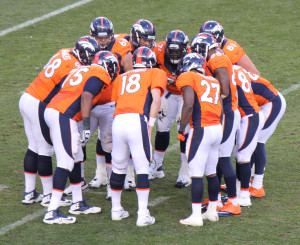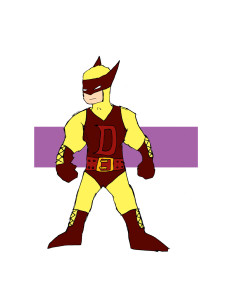Darrin Griffin: Deaf Superhero
Posted: March 30, 2015, 10:42
by Haley Petrey.
Have you ever thought about how your ability to hear affects the way you communicate? As a hearing child of deaf adults (CODA), Darrin Griffin experienced life through the two different worlds of Deaf and hearing cultures.
Griffin was born and raised in one of the hubs for Deaf culture, Austin, Texas, and he wasn’t raised there by chance. From a Deaf culture perspective, Austin is important because it has a lot to offer the Deaf community; and as a CODA, Griffin is accepted into this culture, even as a hearing person.
An important thing to note is that the ‘D’ is capitalized when referring to Deaf culture, and is only lowercase when referring to deafness as an audiological phenomenon.
 Austin: A Deaf hub in the U.S.
Austin: A Deaf hub in the U.S.
As a child, Griffin’s dad attended Texas School for the Deaf, until he reached high school. He then attended a hearing high school where he went on to be the quarterback of the football team. Interestingly, the modern football huddle was invented by a Deaf football team!
Griffin’s mom graduated from Gallaudet University and began teaching at Texas School for the Deaf in Austin.
His parents met for the first time at a Deaf club in Austin and continued to live there and raise a family.
Griffin’s education
Griffin attended school in Austin from elementary through graduate school, and received his undergraduate degree in Deaf studies and deaf education from the University of Texas at Austin. He then moved to Buffalo, New York, in the fall of 2010 to complete his Ph.D and landed a job as a communication professor at the University of Alabama in the fall of 2014.
However, studying Deafness was not originally on his radar. Going into college, Griffin planned to major in physics, as he was very interested in engineering and science.
“I hated it because the people couldn’t communicate and connect with me,” Griffin said. “Then I realized my most passionate elective was sign language; because there was a cultural element. . . a human element.”
This stemmed his interest in Deafness, language and culture. He then took a nonverbal communication studies class, and realized he was really just interested in communication as a whole.
“I found communication studies through deafness, by way of a foreign language class,” Griffin said.

The world of Deafness
“Think of it from a Dr. Seuss perspective,” Griffin said.
Deaf people have their own world and culture, just as hearing people have their own world and culture. Aside from Austin, Texas, that world exists in Washington, D.C.; Rochester, New York; and a few other cities that embrace Deaf culture.
Because many hearing people don’t understand Deaf culture, Griffin has crafted the idea of a Deaf superhero — who helps people understand the Deaf in fun and exciting ways.
Griffin’s goals
“One of my biggest goals as a professor at UA,” Griffin said, “is to help the university, and the appropriate people, initiate American Sign Language classes as a foreign language.”
Currently, The University of Alabama only offers sign language classes through the College of Education. Technically, it is what they call, “signing exact English.” Signing exact English is just that. You’re using your hands and visual signs to represent English. UA uses this approach for children who have special needs and to also aid in educating children with speech difficulties or language disorders.
American Sign Language is much different. It is a separate language; it doesn’t represent English and is completely linguistically independent. It is a foreign language and most universities recognize it as such.
For example, as a premier, leading university, UT Austin had sometimes five or six deaf instructors who taught at least five semesters of ASL, and it would count as a foreign language.
The University of Buffalo is also offering ASL as a foreign language.
“When I got [to Buffalo] there were two deaf instructors,” Griffin said. “By the time I left there were about five. And that happened in four years.”
Schools will begin growing and expanding the programs in which students show interest.
“If you ask any student if they would take ASL,” Griffin said, “for the most part, they’d say yes. It’s fascinating; you learn about the culture and the signs.”
Griffin recognizes that this is long-term goal.
“I think it’s better to let it happen from the ground-up with the students getting interested first,” Griffin said. “I could see within the next year or two, something real start happening.”
Deaf culture at UA
Griffin is currently the academic/faculty adviser for DEAF Hands Speak, which is in the developing stages and, by the end of this semester, will be a student organization recognized by the University.
One of Griffin’s Interpersonal Communication students, Ally Mitchell, is developing DEAF Hands Speak through the 57 Miles organization through the Honors college.
Mitchell’s “brain child” is a Deaf chat, or “silent lunch” type of gathering at the Ferguson Student Center every Wednesday. Mitchell is an honors college student from Arizona and approached Griffin about her idea, after hearing his lecture on Deafness.
“Meeting Allie Mitchell was good, because it’s my second semester and I’ve already met someone who has the same passion and goals that I do,” Griffin said.
Griffin’s involvement in the Deaf chat began as just another participant. But as the most advanced signer, he does a lot of coaching when he attends.
“It’s still the same without me,” Griffin said. “It’s a great organization that brings together students from different parts of campus, so it’s cool.”
Griffin’s next step to reaching his goal for The University of Alabama is offering a May interim class called Deaf Perspectives. The class will be based on Deaf culture from a deafness viewpoint.
Griffin’s advice
Griffin’s advice for anyone in any field of communication — or just life advice in general — is to understand “that perception is not reality.”
“We all live in a shared reality based on perceptions,” Griffin said. “But they’re all so different, and somewhere in between these two or — thousand — perceptions there’s reality. The truth is always between both stories.”




